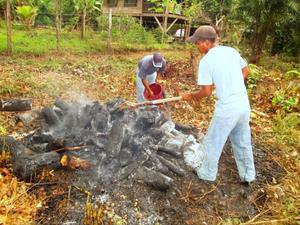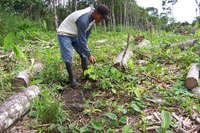Biochar: Soil Supercharger
/ Liriano and Yin make biochar. Click for a larger view.This week we'll be making biochar in the Arimae plantation. Biochar is relatively easy to make and should improve the quality of the soil in our projects, meaning higher plantain yields and faster growing trees. It's also a great way to take advantage of the fallen trees and branches that are normally a nuisance.
Liriano and Yin make biochar. Click for a larger view.This week we'll be making biochar in the Arimae plantation. Biochar is relatively easy to make and should improve the quality of the soil in our projects, meaning higher plantain yields and faster growing trees. It's also a great way to take advantage of the fallen trees and branches that are normally a nuisance.
In February, Liriano, Yin, and I visited regional biochar expert and former Peace Corps Volunteer Alan Foster in Catrigandi, Panama Este to learn how to make biochar. We started the process by sawing mango tree branches into equal-sized logs and stacking them into a big five foot pile. Then we lit the pyre on fire, evoking the spirit of the limbs that were sacrificed for sake of soil improvement. Check out all the photos.
During the burn, Alan trained us to be aware of the changes of the smoke over time: white or light blue smoke means that moisture is being burned off, while darker smoke means the wood is burning. Once the wood was slightly crisped we extinguished the smoldering logs with water, and using a shovel we scraped off the biochar from the logs. Through a four hour burn of a 4x4x5 pyre we collected a sack of biochar, and this process is repeated.
We are adapting our process slightly due to the space limitations in our plantations: rather than stacking the wood in a pile, we are going to dig a pit. And because there is no water nearby, we are going to extinguish the smoldering by sealing off airflow by burying it.
This biochar is like an uncharged battery: it can potentially absorb nutrients from the soil and actually reduce yields! To "charge" it, Alan will use his biochar as a dry material for his composting latrine. We plan on adding our biochar to a mix of rice husk and chicken excrement to create a rich organic fertilizer, and expect to use this in the tree nursery for healthier trees and fatter plantains.




